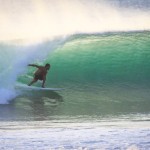 Patients often ask me what brought me to Osteopathy. It was a logical progression after a 10 years career as a physical education teacher and personal trainer. Having been in contact with elite athletes for a long time, I was working closely with various Osteopaths and Physiotherapists, and increasingly developed an interest in what they were doing. Helping patients alleviate pain seemed more meaningful than preparing athletes for competition. The intellectual and physical aspects of the job always had interested me, and as a hands on, manual therapy, Osteopathy won over Physiotherapy, which I saw as a bit too close to what I was already doing.
Patients often ask me what brought me to Osteopathy. It was a logical progression after a 10 years career as a physical education teacher and personal trainer. Having been in contact with elite athletes for a long time, I was working closely with various Osteopaths and Physiotherapists, and increasingly developed an interest in what they were doing. Helping patients alleviate pain seemed more meaningful than preparing athletes for competition. The intellectual and physical aspects of the job always had interested me, and as a hands on, manual therapy, Osteopathy won over Physiotherapy, which I saw as a bit too close to what I was already doing.
Some time ago I asked myself: “ What is the real reason that led me to where I am now?” And to answer that I have to go back in time and get a bit more personal; and why not? After all, my patients display their physical and sometimes emotional pain (which are by definition related), so why shouldn’t I share mine. So let’s get back in time, before my professional career and before my teenage years when I was pursuing the dream of being an elite cyclist.
I was about 10 years of age when I insidiously developed an idiopathic scoliosis, which is a sideways curve in the spine. Scoliosis can either be congenital (caused by vertebral anomalies present at birth), idiopathic (cause unknown) or secondary to a primary condition like leg length discrepancy. Mine appeared without obvious reason and was later detected at school. As its severity did not require surgery (a major operation where metal rods are fixed to the spine to straighten it, only reserved for extreme cases where the curve is greater than 45°), I was left with little option: a brace that I should have worn for a few years with uncertain outcome (the research at the time gave inconsistent conclusions), or managing it as well as I could, with the current, limited orthopaedic knowledge. That’s what I did.
Being physically active greatly helped me to strengthen my back musculature and to minimise the progression of the curvature. Regular osteopathic treatment helped to reduce the uneven tensions and to balance the range of motion of my spine. Competing and succeeding in an elite sport also helped me mentally to overcome my physical limitations. It gave me the extra motivation to perform better. I started to use the condition as an “engine” to challenge myself and to reach goals that I never thought possible. I continued exploring the possibilities of my body by studying physical education at University and later strength and conditioning, to finally train weekend warriors and professional athletes to achieve their goals.
Of course a scoliosis is not only visual: it can also bring all sort of discomfort, mostly when the body is tired and stiff. The uneven rotations and bends of the spine means that tensions are often concentrated in specific areas of the back, which in turn restricts movement and sometimes causes pain. When moderate to severe it also affects the way the shoulders and hips are moving, and even influences the mechanics of the legs and arms. As a chronic condition it requires regular care, and Osteopathy was always my treatment of choice. As a holistic manual medicine, Osteopathy integrates all the different parts of the body that are involved in scoliosis (extending far beyond the spine), literally from head to toes. It also takes account of the psychological state, as suffering from an ongoing condition can be mentally draining. I have always felt amazing after a treatment, and that also determined my choice of becoming an Osteopath. What I find fascinating with Osteopathy is the interconnectivity between all parts of the body. I became even more aware of that as I started experiencing niggly pain or discomfort in areas away from the principal restrictions that were in fact related. When patients tell me that as their lower back feels out of balance and also have shoulder or neck pain; it makes perfect sense!
Beyond these anatomical and biomechanical considerations, what can we learn from our physical restrictions?
All of us have experienced pain in our lives, most of us have areas of tightness and stiffness in our body and some are carrying an injury that causes recurrent discomfort. And all of these can be helped by treatments, exercises and most importantly attitude! Our health issues can become a motivation to challenge oneself, to achieve goals once thought unreachable, but also to understand others and to develop empathy. Enjoying what we have is the most important, staying positive is paramount and accepting who we are is the key of making the most of ourselves and reaching our full potential. Perfect is what it is, so smile, we have all been gifted with a body, a mind and an existence. The way you use the first 2 determines the third!
François Naef, Osteopath





